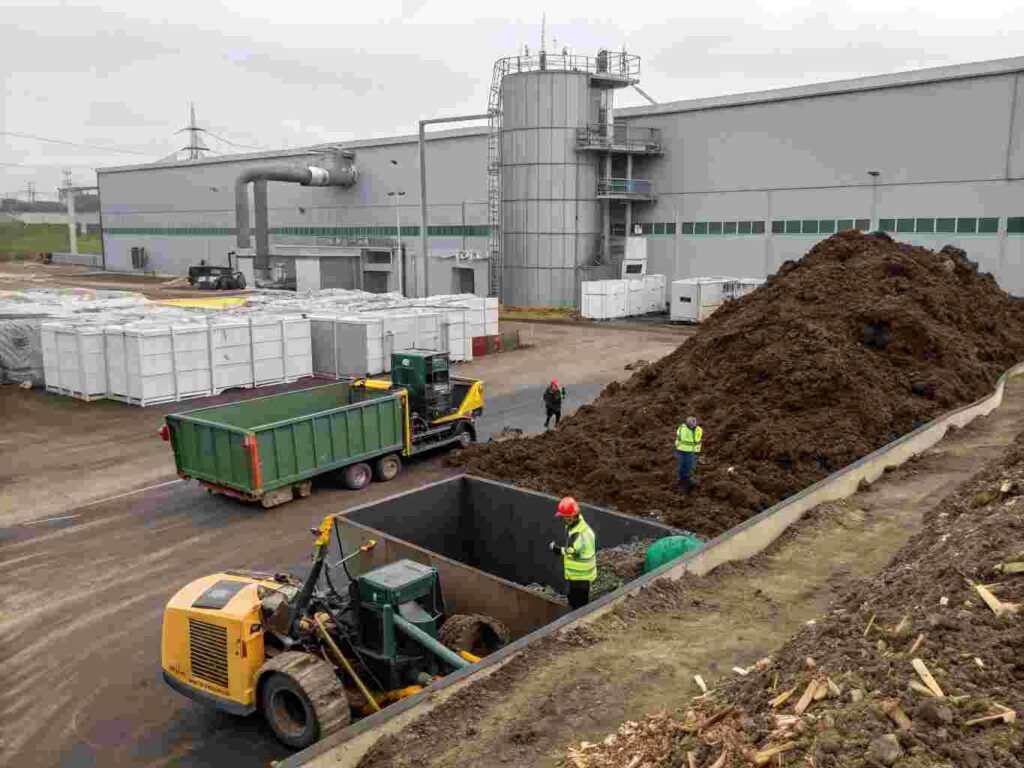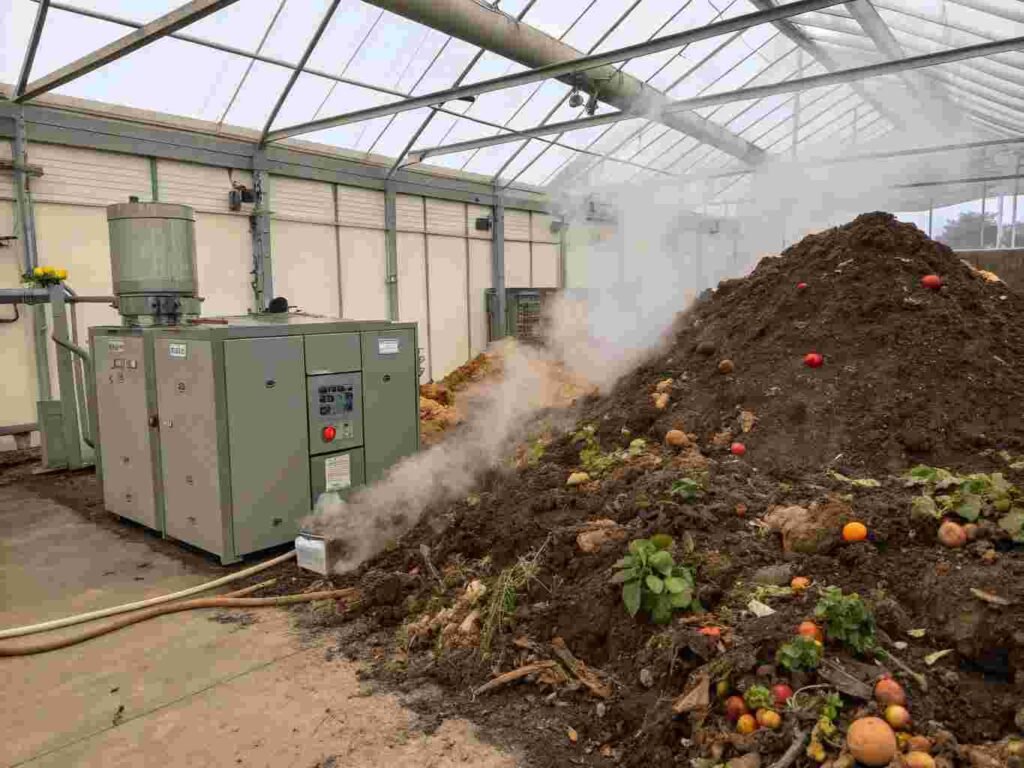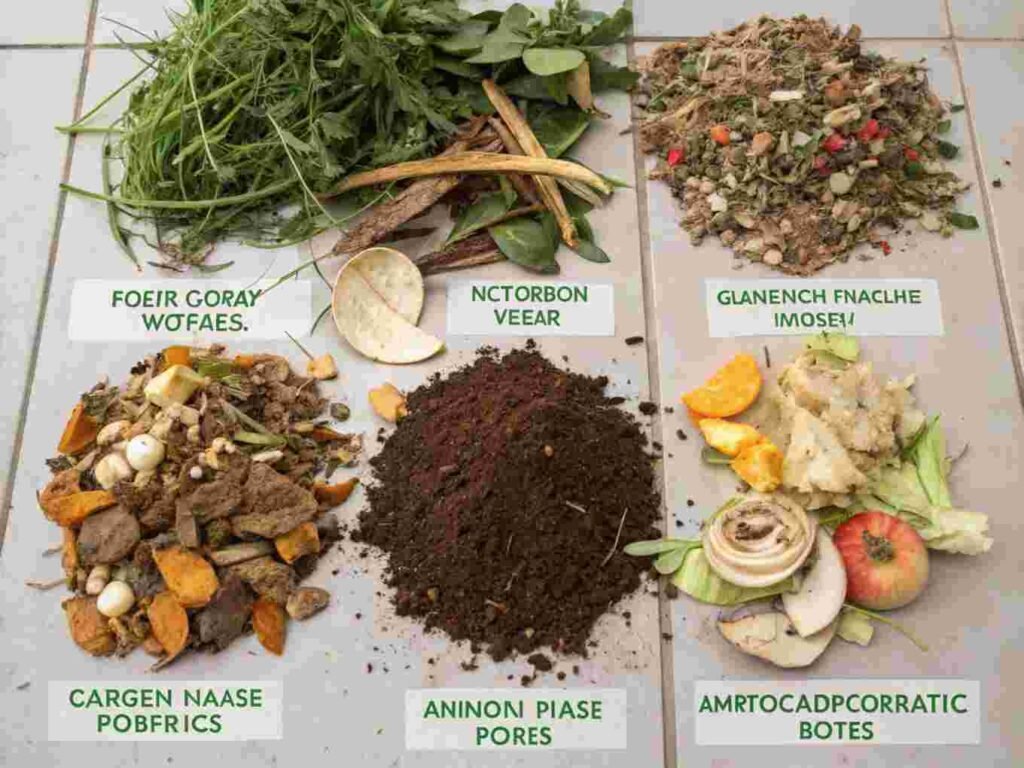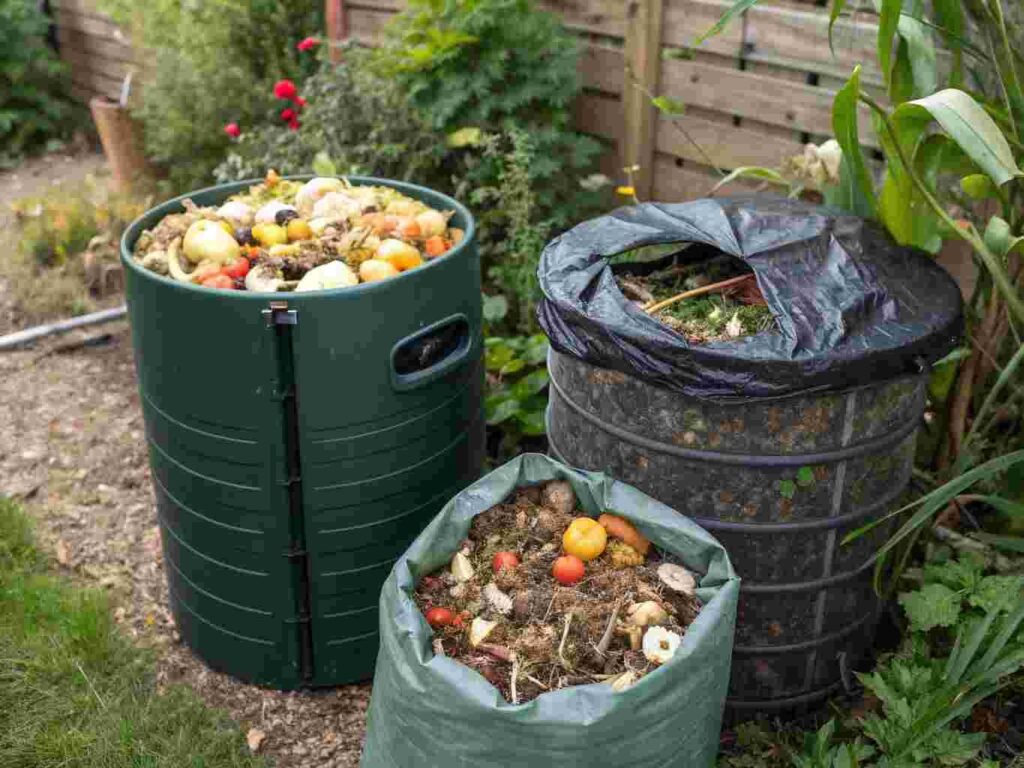With landfills overflowing and climate change looming, industrial composting (commercial or large-scale composting) is booming. It's a powerful organic waste treatment center, transforming vast quantities of biowaste into soil gold. Industrial composting disrupts the traditional landfill model by accelerating aerobic decomposition in a controlled environment, significantly reducing emissions and producing nutrient-rich compost.
This guide will help you understand whether those biodegradable plastics actually break down. We'll cover the basics of industrial-scale composting, its benefits, regulations, and how to set up your own composting business.
 industrial composting
industrial composting
What Is Industrial Composting?
Industrial composting is essentially a more sophisticated version of professional composting. In a controlled environment, organic materials like food scraps, yard clippings, and even bioplastics are broken down by microorganisms. Waste-to-compost systems process large quantities of waste daily, far exceeding the capacity of home composting facilities.
Working Principle of Industrial Composting
- Temperature: The compost pile is naturally heated or mechanically controlled to maintain a high temperature stage above 50°C to promote rapid decomposition and kill pathogens and weed seeds.
- Humidity: Maintain a humidity of about 50% to ensure microbial activity and avoid anaerobic environment caused by excessive dryness or humidity.
- Ventilation: Sufficient oxygen is provided through mechanical turning or blowing system to maintain aerobic decomposition process.
- Microbial action: A variety of aerobic microorganisms synergistically decompose organic matter to produce humus.
In the industrial composting process, mechanical equipment regulates air circulation, temperature and moisture to ensure a stable environment in the compost pile and high decomposition efficiency. The composting cycle generally ranges from 30 to 180 days, which is much faster than home composting.
 working principle of industrial composting
working principle of industrial composting
Types of Industrial Composting
Windrow Composting:Organic waste is piled into long rows (windrows) about 4-8 feet high and 15 feet wide. These piles are regularly turned to maintain aeration and temperature, typically taking around four months to produce compost.
Static Pile Composting: Organic matter is mixed with dry materials like wood chips and placed in large piles. Airflow is maintained either naturally or via pipes beneath the pile, reducing the need for turning.
In-Vessel Composting (IVC): Organic material is shredded and placed inside enclosed vessels (drums, silos, or tunnels) where temperature, moisture, and oxygen are precisely controlled. This method is faster (about one month) and ideal for processing food waste and biosolids but requires specialized equipment.
Aerated Static Pile (ASP) Composting: Similar to static piles but with active aeration systems blowing air through the piles to optimize microbial activity.
Anaerobic Digestion: Though technically different, this process breaks down organic material without oxygen, producing biogas and digestate used as fertilizer.
Insect Processing Units: Emerging technology using insects to consume and break down food waste rapidly under controlled conditions.
How Big Is the Compost Industry?
The industrial composting industry has grown rapidly worldwide as governments, businesses, and consumers seek sustainable waste management solutions. Globally, millions of tons of organic waste are processed annually in commercial composting facilities, with the market expanding due to increased regulatory support and demand for organic fertilizers.
In countries with advanced waste management policies, industrial composting forms a key part of circular economy strategies, handling food waste from restaurants, landscaping residues, agricultural byproducts, and certified compostable packaging. The industry includes a wide range of operators from small regional facilities to large-scale plants processing thousands of tons per year.
 industrial composting
industrial composting
How Does Industrial Composting Work?
Shredding and Mixing: Waste is shredded to increase surface area and mixed to balance carbon and nitrogen content.
Controlling Temperature: Maintaining temperatures between 55-70°C (131-158°F) accelerates microbial activity and kills pathogens and weed seeds.
Aeration: Regular turning or forced airflow supplies oxygen essential for aerobic decomposition.
Moisture Management: Moisture is kept at ideal levels (40-60%) to sustain microbial life without creating anaerobic conditions.
Time: Depending on the method, composting takes from a few weeks (in-vessel) to several months (windrow)
Different Methods of Industrial Composting
Windrow Composting
Windrow composting is widely used for its simplicity and ability to handle large volumes. Large organic waste rows are turned periodically with machinery to maintain oxygen flow and uniform decomposition.
Static Pile Composting
Static piles rely on natural or forced airflow through the pile. This method requires less labor but careful design to ensure adequate aeration and temperature control.
In-Vessel Composting (IVC)
IVC offers the most control and fastest processing times. Organic waste is enclosed in a vessel where mechanical systems regulate temperature, moisture, and oxygen. This method is ideal for sensitive or high-moisture waste streams and urban settings with limited space.
Aerated Static Pile (ASP)
ASP combines static piles with active aeration systems, often using blowers and perforated pipes to optimize oxygen supply and temperature control.
 types of waste that can be processed by industrial composting
types of waste that can be processed by industrial composting
Types of Waste That Can Be Processed by Industrial Composting
Compostable materials include food scraps (vegetables, meat, and even oily materials), green waste disposal, and certified bioplastics that meet ASTM D6400 decomposition standards. But beware: regular plastics can contaminate compost, turning even high-quality compost into waste.
- Food scraps, kitchen waste
- Garden waste, such as fallen leaves and grass clippings
- Animal manure and agricultural waste
- Special materials such as biodegradable plastics and bones
Regulations ensure safety. In the US, the EPA oversees compost quality and pathogen control, while EU directives promote guidelines for biodegradable products and waste diversion programs. Starting in 2025, updated regulations include increased composting subsidies to achieve net-zero emissions targets—for example, tax breaks for facilities that reduce emissions. Globally, policies like the EU Green Deal are integrating composting into broader waste management costs.
Health and safety? Critical in a post-pandemic world. Workers need to develop protocols for handling biowaste, such as wearing personal protective equipment (PPE) and maintaining ventilation to avoid dust or pathogens. High temperatures ensure disinfection, but hygiene standards are non-negotiable for community composting facilities.
Home Compost vs Industrial Compost
Home composting is slow and primarily processes vegetable scraps from backyard trash cans—excluding meat, dairy, and those challenging biodegradable plastics that require industrial heat to fully decompose.
Industrial-scale composting uses methods such as windrow composting (machines turning long strands of compost), container composting (using closed containers to control odors), or aerated static composting (using pipes to pump air into the compost pile).
The advantages are faster processing and a wider variety of compost types. The disadvantages are that they require large equipment and space. If you handle municipal composting of urban waste, industrial-scale composting can be very beneficial.
| Feature | Home Composting | Industrial Composting |
|---|---|---|
| Scale | Small, backyard or indoor bins | Large-scale commercial facilities |
| Processing Time | Several months to over a year | Weeks to a few months |
| Waste Types | Mostly yard and kitchen scraps | Wide range including meat, dairy, bioplastics, bones |
| Process Control | Natural conditions, minimal control | Controlled temperature, moisture, aeration |
| Equipment | Basic tools (bins, aerators) | Specialized machinery (shredders, aerators, vessels) |
| End Product Quality | Variable, depends on conditions | Consistent, pathogen-free, market-ready compost |
Industrial Composting Equipment
- Shredders and Grinders: Reduce particle size to speed decomposition.
- Turners: Machines that aerate windrows by turning the piles.
- Aeration Systems: Blowers and perforated piping for static and aerated static pile composting.
- In-Vessel Composters: Enclosed reactors with automated controls for temperature, moisture, and mixing.
- Screeners and Sifters: Separate finished compost from larger particles.
- Monitoring Systems: Sensors and software track temperature, moisture, and oxygen levels to optimize the process.
 trash bag composting vs. traditional compost bins
trash bag composting vs. traditional compost bins
Common Problems that Can Occur During Composting
| Problem | Cause | Solution |
|---|---|---|
| Odors | Anaerobic conditions, too wet | Add dry materials, increase aeration, turn pile |
| Pests and Rodents | Food scraps like meat or dairy | Avoid these materials or use enclosed systems |
| Slow Decomposition | Imbalanced carbon/nitrogen ratio, low temperature | Adjust feedstock mix, increase temperature, aerate more |
| Excess Moisture | Rain infiltration or overwatering | Cover piles, add dry browns, improve drainage |
| Insufficient Heat | Large particle size, poor aeration | Shred materials, turn pile regularly |
Environmental and social benefits of industrial composting
Industrial composting is highly effective in reducing methane emissions from landfills, in some cases by up to 90%. It converts organic waste into organic fertilizer, which promotes soil health and crop yields. Industrial composting plays a key role in the circular economy, closing the waste loop.
Industrial composting contributes to carbon sequestration by returning carbon to the soil. Studies have shown that when used as an amendment, industrial compost can sequester several tons of CO2 per acre. Furthermore, industrial compost is highly resilient—better than open dumps in the event of floods or heat waves.
If managed properly and with adequate ventilation, industrial composting does not always produce a foul odor. While the contamination from non-compostable waste is a drawback, it is far outweighed by the environmental benefits, such as reduced greenhouse gas emissions and landfill diversion.
Emerging Technologies and Innovations
Automation and the Internet of Things (IoT) in the composting industry mean sensors can track temperature, humidity, and oxygen levels in real time, alerting operators via apps to make adjustments for optimal efficiency.
Is AI being used in waste management? It's already here, optimizing compost turning or predicting decomposition rates. Drones can detect hotspots in aerated piles, or automated, self-regulating in-vessel systems can be developed. What about integration? Combining industrial composting with anaerobic digestion creates a waste-to-energy solution, producing biogas while simultaneously producing compost—a true zero-waste cycle.
Urban composting solutions are also booming, with compact facilities in cities using these technologies to process large volumes of compost without generating odor. Global composting trends suggest that scalable innovations are emerging, such as mobile composting units suitable for rural areas, making organic waste decomposition accessible anywhere.
Economic and Business Opportunities
Starting a composting business? The initial cost of equipment (shredder, compost turner) can be as high as $100,000 to $1 million, in addition to land and labor costs. Operating costs? Think $50 to $100 per ton of waste processed, including energy and maintenance.
What about the return on investment for composting? It's quite substantial. Revenue from tipping fees (the fee haulers pay to dump waste) and compost sales (up to $50 per cubic yard) can generate a 20-40% return within 2-3 years. Use a compost calculator to plug in your numbers—and factor in compost subsidies to significantly reduce startup costs.
How to Get Started
1. Choose a site—close to the waste source but away from residential areas. Obtain a permit according to composting regulations.
2. Scale up and market to farms in need of soil improvement.
Case studies show that small operations can generate $500,000 in annual revenue. This is the composting market gold mine in the green economy of 2025.
Global Case Studies
In the US, a municipal program in San Francisco diverts 80% of waste through commercial composting, significantly reducing emissions. And in Europe? Swedish facilities have combined technology and policy to achieve near-zero landfill for organics. Developing countries like India are using modified windrowing in urban slums, creating jobs.
Avoid common mistakes, such as improper material sorting, which can lead to compost contamination. Troubleshooting: Regular audits and education can address this issue. Not all bioplastics are effective; check for certifications.
Looking for a facility? Use an online composting facility locator or app—enter your zip code to find nearby industrial composting services. Best Practices: Start small, use tools for monitoring, and participate in waste diversion programs.
Helpful Tools and Resources
Get hands-on! Try using an online waste audit tool to assess your waste stream. The Material Compatibility Checker can determine if your packaging is truly compostable. For businesses, the Return on Investment (ROI) Calculator on the EPA website can quickly calculate the numbers.
**Resources?
Review OSHA's composting safety regulations or visit forums like r/composting on Reddit for tips. Get links to composting facilities through BPI World or local directories. Join a community composting group for support.
Ready to take action?
Audit your waste, find a composting facility, or advocate for more subsidies—small steps can make a big difference.
Conclusion
Industrial composting, a powerful engine for large-scale organic waste processing, is essential for sustainable development in 2025. From reducing emissions to fueling farms, it's our ticket to a greener planet.
Looking ahead, driven by artificial intelligence and policy, it will play an even greater role in global waste trends. Remember, whether you compost at home or on a commercial scale, every bit counts.
Last updated: August 16, 2025 at 13:26 pm




